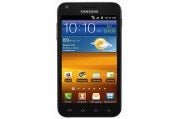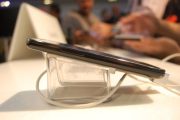HTC Evo 3D Review: Dual-Core, 3D Display, 4G Speeds
I'm not sold on 3D for consumer devices, and I'm certainly skeptical of it on a smartphone-size screen. However, Sprint and HTC make a great team, so I decided to keep an open mind about the HTC Evo 3D. Did the Evo 3D change my opinion of 3D phones? Well, let's just say it is a very good thing that there's more to this phone than just a 3D display.
 First and foremost, the Evo 3D is a gorgeous phone. Like the Evo 4G, the Evo 3D is black with blood-red detailing. Keeping it in the family, the Evo View Android tablet, also announced today, has the same color scheme. The Evo 3D smartphone feels solid, but not bulky in the least. It has a nice, textured rubber backing and a slimmer shape that feels good in hand.
First and foremost, the Evo 3D is a gorgeous phone. Like the Evo 4G, the Evo 3D is black with blood-red detailing. Keeping it in the family, the Evo View Android tablet, also announced today, has the same color scheme. The Evo 3D smartphone feels solid, but not bulky in the least. It has a nice, textured rubber backing and a slimmer shape that feels good in hand.
With the battery in place, the HTC Evo 3D weighs 6 ounces. It measures about 5 inches tall, nearly 3 inches wide, and 0.47 inches thick. Its display is a 4.3-inch 3D touchscreen with a sheet of Gorilla Glass for added toughness. Unlike the Evo 4G, the Evo 3D doesn't sport a kickstand--mainly because the twin 3D cameras occupy most of the space on the rear.
You need to maintain an absolute dead-on viewing angle to properly appreciate the third dimension, though. If you're viewing at a slight angle, the image will look like a blurry mess. This can be difficult with a small screen. With an image or a short video clip, it isn't too hard to hold the phone directly in front of your eyes for a few seconds. And don't even think about trying to watch 3D movies outside; it completely fades in bright sunlight. If you don't want to view 3D images and prefer to stick to the standard 2D display, a toggle switch on the side of the device allows you to turn the effect off.
The new version of Sense also has a spruced-up Walls system. Rather than having to flick back and forth between your walls, as you do in the stock Android operating system, you can flick the Evo 3D's screen to make the walls spin. The effect is slightly reminiscent of a carousel and makes navigation a little easier.
You'll find a clutch of new widgets in Sense, but my favorite is the gorgeous new Weather widget. HTC has a nice tradition of creating visual weather apps, and it is cool to see the company continue to improve them. They might not always be pretty, but they sure are dramatic.
So how much of a difference does dual-core make? We matched the Evo 3D up against its predecessor, the HTC Evo 4G (a single-core device), and there's quite a big difference--one you'll notice as soon as you turn on the phone. The Evo 4G had a startup time of 74 seconds (!), while the Evo 3D had a much faster startup time of 13.7 seconds.
Solid, Beautiful Design
 First and foremost, the Evo 3D is a gorgeous phone. Like the Evo 4G, the Evo 3D is black with blood-red detailing. Keeping it in the family, the Evo View Android tablet, also announced today, has the same color scheme. The Evo 3D smartphone feels solid, but not bulky in the least. It has a nice, textured rubber backing and a slimmer shape that feels good in hand.
First and foremost, the Evo 3D is a gorgeous phone. Like the Evo 4G, the Evo 3D is black with blood-red detailing. Keeping it in the family, the Evo View Android tablet, also announced today, has the same color scheme. The Evo 3D smartphone feels solid, but not bulky in the least. It has a nice, textured rubber backing and a slimmer shape that feels good in hand.With the battery in place, the HTC Evo 3D weighs 6 ounces. It measures about 5 inches tall, nearly 3 inches wide, and 0.47 inches thick. Its display is a 4.3-inch 3D touchscreen with a sheet of Gorilla Glass for added toughness. Unlike the Evo 4G, the Evo 3D doesn't sport a kickstand--mainly because the twin 3D cameras occupy most of the space on the rear.
3D Display
One of the most important features of the Evo 3D is, of course, its 3D display. The phone uses parallax barriers to display 3D images and video, without the need for clunky 3D glasses (similar to the concept used on the Nintendo 3DS). The Evo 3D's 4.3-inch qHD 960-by-540-pixel screen looks terrific in 2D--and pretty good in 3D, as well. Let me be clear, however: This isn't the kind of 3D you'd see at the movie theater. Images aren't exactly flying in your face. Rather, it looks like you can peer into the phone much like a diorama.You need to maintain an absolute dead-on viewing angle to properly appreciate the third dimension, though. If you're viewing at a slight angle, the image will look like a blurry mess. This can be difficult with a small screen. With an image or a short video clip, it isn't too hard to hold the phone directly in front of your eyes for a few seconds. And don't even think about trying to watch 3D movies outside; it completely fades in bright sunlight. If you don't want to view 3D images and prefer to stick to the standard 2D display, a toggle switch on the side of the device allows you to turn the effect off.
New HTC Sense User Interface
Like the HTC Sensation, the Evo 3D comes with the latest version of the Sense user interface. Sense 3.0 has a brand-new customizable lock screen. You can pick a theme for your lock screen (the phone offers quite a few to choose from) and then select four apps that you visit the most. When you turn on your phone, you'll see those four apps at the bottom of the screen. To unlock your phone, you drag the circle and move it over an app; you then jump straight to that app. That way, you don't have to go through multiple menus to reach your e-mail or any other items you access frequently.The new version of Sense also has a spruced-up Walls system. Rather than having to flick back and forth between your walls, as you do in the stock Android operating system, you can flick the Evo 3D's screen to make the walls spin. The effect is slightly reminiscent of a carousel and makes navigation a little easier.
You'll find a clutch of new widgets in Sense, but my favorite is the gorgeous new Weather widget. HTC has a nice tradition of creating visual weather apps, and it is cool to see the company continue to improve them. They might not always be pretty, but they sure are dramatic.
Performance
The Evo 3D is powered by a 1.2GHz dual-core Qualcomm Snapdragon processor. The Snapdragon processor supports advanced 3D technology, including full 1080p 30-frames-per-second HD video and stereoscopic 3D video capture and playback.So how much of a difference does dual-core make? We matched the Evo 3D up against its predecessor, the HTC Evo 4G (a single-core device), and there's quite a big difference--one you'll notice as soon as you turn on the phone. The Evo 4G had a startup time of 74 seconds (!), while the Evo 3D had a much faster startup time of 13.7 seconds.
 Blog RSS Feed
Blog RSS Feed Via E-mail
Via E-mail Twitter
Twitter Facebook
Facebook












































